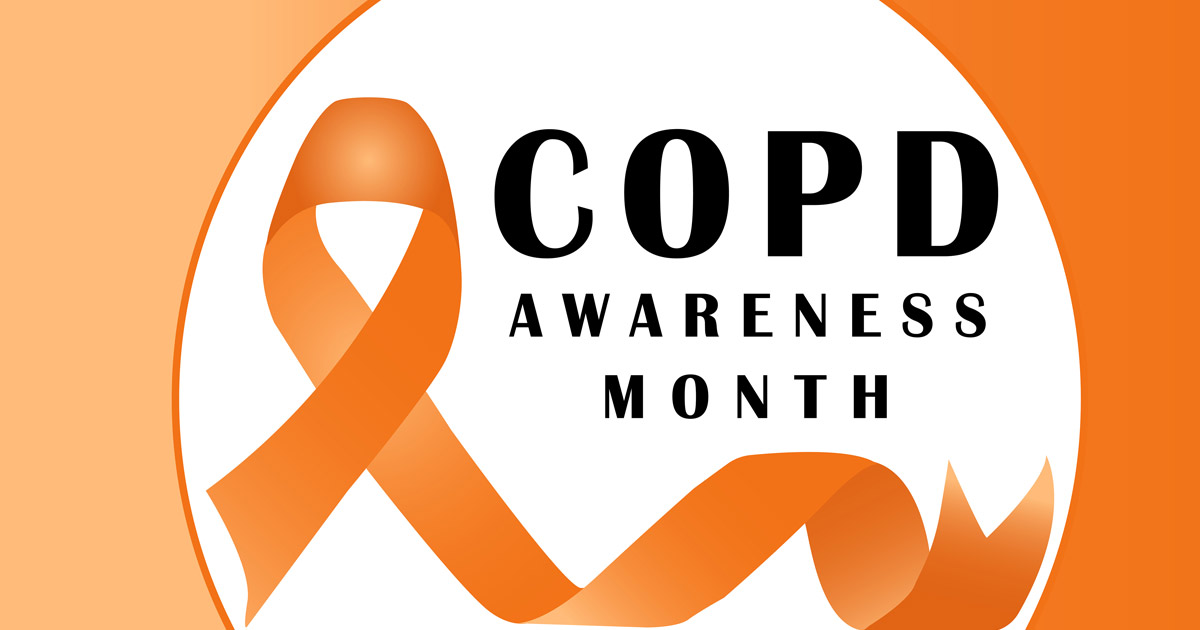November is Chronic Obstructive Pulmonary Disease (COPD) Awareness Month. COPD is comprised of a group of progressive lung illnesses, including emphysema, irreversible asthma, and chronic bronchitis. Emphysema is a condition where the ends of the smallest air passages of the lungs are no longer functional. With chronic bronchitis, the lining of the bronchial tubes in the lungs are continually inflamed. The lungs of those suffering from COPD lose their natural elasticity, impairing airflow out of the lungs.
Symptoms include frequent coughing, wheezing, shortness of breath, tightness in the chest, lack of energy, frequent respiratory infections, excess phlegm or sputum, and trouble taking a deep breath. Usually symptoms do not appear until the lungs are significantly damaged. COPD can make it difficult to work or even accomplish daily tasks. Those suffering from COPD are at an increased risk for other conditions such as lung cancer, heart disease, and depression.
What Causes COPD?
COPD is caused by lung irritants, such as tobacco smoke, dust, and air pollution. Irritants are tiny particles that when inhaled, cause damage to the lungs. Some workplaces have polluted air that contains chemicals, dust, fibers, metals, vapors, or fumes and gases that put workers at risk for developing COPD. Workers who smoke are at an even higher risk. COPD can develop either by long term exposure to small amounts of irritants or short-term exposure to a large amount of irritants.
After heart disease, cancer, and stroke, COPD is the fourth leading cause of death in the United States. Every four minutes, someone dies of COPD and women are more often victims than men.
Who is at Risk of Developing COPD?
Workers in certain occupations have a high risk of exposure to the irritants linked to COPD. The following industries have higher rates of work-related COPD:
- Coal mining
- Gold mining
- Granite quarries
- Tunnel work
- Concrete manufacturing
- Brick manufacturing
- Construction work
- Food processing
- Textile manufacturing
- Agriculture
- Welding
- Plastic and rubber manufacturing
- Leather manufacturing
- Paper manufacturing
Mining and working with concrete or granite produces harmful dust. Silica, coal, and mineral dusts can cause serious lung damage. The processing of grains and flours also produces dust that can harm workers. The production of plastics, rubber, and leather requires the use of toxic chemicals that can pollute the air in facilities where they are made. In industries such as textile manufacturing and agriculture, the risk of COPD comes from both dust and exposure to fumes from chemicals being used.
How can Workplace COPD Hazards Be Reduced?
Every employer has the responsibility to provide a safe workplace free of hazards that can harm workers. This includes following standards and guidelines set by the Occupational Safety and Health Administration (OSHA) for air quality and dust control. Proper ventilation systems are key to reducing the amount of dust, fumes, and vapors in the workplace. Employers must also provide personal protective equipment (PPE) and train workers on best practices for reducing dust exposure, including:
- Allowing dust to settle before handling materials and equipment
- Avoiding working around open containers
- Using good housekeeping and maintenance procedures that keep the workplace and machinery as clean as possible
- Wet mopping or washing floors instead of sweeping
- Using industrial vacuums with hoods to reduce dust during work
- Wearing PPE while working in tight spaces or other circumstances where the air quality is difficult to control
Workers also have a responsibility for their own safety in the workplace. The most effective preventative measure against COPD is to refrain from smoking as it greatly increases the risk of damage to the lungs. Another important practice for workers is to pay attention to their clothing and clean it regularly. Certain types of fabric, such as heavy winter coats, absorb more dust and should be vacuumed and cleaned or they can become a source of dust exposure.
In industries where workplace air quality is a known risk, safety programs should include yearly breath testing. This non-invasive test, known as spirometry, measures lung function and will show any changes due to occupational exposure. Offering annual flu vaccinations and regular vaccination against pneumococcal pneumonia also helps reduce risk, prevent infections, and keep lungs healthy.
Am I Eligible for Workers’ Compensation Benefits?
Workers’ compensation exists to help injured workers cover the cost of treatment for injuries from a work accident. It also covers disabilities and occupational illnesses. An occupational illness is one that arises out of and in the course of employment. According to the New Jersey Workers’ Compensation Act, the causes and conditions of the illness must be related to the worker’s particular trade, occupation, process, or place of employment. COPD qualifies as an occupational illness under this definition.
How to File a Claim for COPD
There is a statute of limitations of two years for workers’ compensation claims. This applies to injuries from work-related accidents. Because some occupational illnesses develop over time and may take years to show symptoms, the statute of limitations for work-related diseases is different. The two-year limit starts from the date you discovered or should have known that your illness was caused by your work environment. Proving a claim for an occupational illness can be difficult and many times, employers or their insurers will try to avoid paying benefits. In COPD cases, they may try to argue that smoking or second-hand smoke was the cause of illness.
The burden of proof for showing the link between a worker’s occupation and their COPD falls on the worker. It is advisable to consult with an experienced workers’ compensation lawyer who will know exactly what evidence is needed to support a claim for COPD. A successful occupational illness claim could result in some or all of the following compensation:
- Medical benefits to cover the cost of treating COPD, including hospitalization, prescription medications, and rehabilitation therapy
- Wage loss benefits to compensate for lost earnings
- Permanent partial disability benefits or permanent total disability benefits
- Death benefits to be paid to surviving dependents of a worker whose illness is fatal
COPD Awareness Month
At least 16 million people in the U.S. have been diagnosed with chronic obstructive pulmonary disease, but the true numbers are most likely much higher as there are many more cases that go undiagnosed. According to the Centers for Disease Control and Prevention (CDC) more than 50 percent of adults suffering from low pulmonary function were not aware they had COPD. Orange is used to show support for those with COPD. Wearing orange, attending health fairs, and taking advantage of community resources are all ways to raise awareness of COPD and help people get treatment and manage symptoms. Encourage anyone with wheezing, chest tightness, or low energy to see a doctor. Early treatment can help control the damage to lungs, control symptoms, improve quality of life, and reduce the risk of heart disease and lung cancer.
South Jersey Workers’ Compensation Lawyers at Pietras Saracino Smith & Meeks, LLP Advocate for Workers with Occupational Illnesses
If you have an occupational illness or lost a loved one to an occupational illness, contact the South Jersey workers’ compensation lawyers at Pietras Saracino Smith & Meeks, LLP. We have the knowledge and resources you will need by your side for a successful outcome. To schedule a free consultation, call 856-761-3773 or complete our online contact form. Located in Cherry Hill, New Jersey, we advocate for injured workers throughout South Jersey, including Camden, Cinnaminson, Delran, Maple Shade, and Pennsauken.













